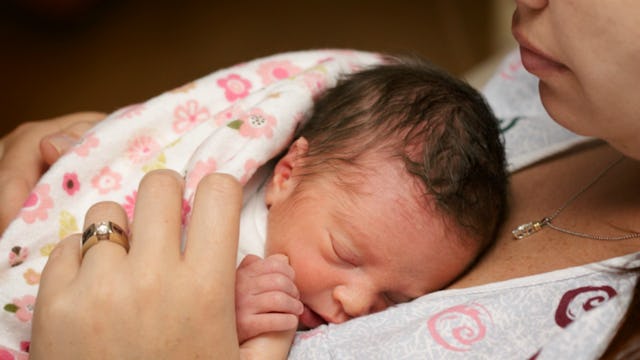Premature Birth Rates Have Increased For Black and Hispanic Women ONLY

Just a few years ago, it looked like the rates of premature births in America were decreasing. The CDC reports that from 2007-2014, our premature birth rates declined in part due to an decrease in overall teen/young adult pregnancies. This was a good thing, because while it’s true that care for premature babies is constantly improving (yay!), preemies are more vulnerable to disabilities, infection, long-term health concerns, and—tragically—death.
So, although premature births do happen, and no mom should feel shamed or like she failed if she had a premature birth, we need to do everything in our power to help moms keep their babies inside for as long as possible.
Unfortunately, though, it looks like we’ve been doing a worse job of that lately. A new report from the CDC shows a troubling new increase in premature births. The report, released in May of this year, found that preterm birth rates have increased every year for the past three years. The rate rose from 9.86 in 2016 to 9.93 in 2017, and increased a total of 4% between 2014 to 2017.
This is all worrying enough, because even that small percentage amounts to thousands of babies who are in a more vulnerable position in life due to a preterm birth. But perhaps the most disturbing—infuriating, actually—aspect of all this is that the increase has occurred quite strikingly among racial lines.
Yep, the CDC reports that there was a disproportionate increase of premature births among black and Hispanic women, but no discernable increase among white women.
WTAF. Is this really the world we live in?
“Preterm rates increased for births to non-Hispanic black (13.77% to13.92%) and Hispanic (9.45% to 9.61%) women from 2016 to 2017; the rate was essentially unchanged among births to non-Hispanic white women (9.04% to 9.06%),” writes the CDC in their report.
In a way, this shouldn’t really surprise anyone who has kept up with maternal child health over the past few years. Women of color have higher maternal and infant mortality rates than anyone else. And a report came out last year showing that race often affects the quality of care infants receive in the NICU.
Still, having another racial injustice laid out right before one’s very eyes—especially one that is so potentially harmful to our next generation of little ones—is enough to make one’s rage spiral completely and utterly out of control. Just…UGHHHH.
We at Scary Mommy were able to touch base with the brilliant Kweli Rashied-Henry, Director of Health Equity at March of Dimes to help put these stats in context for us—and most importantly, shed some light about what can be done about an injustice like this.
First, the million dollar question: What’s causing glaring racial disparities like this one?
“Persistent underlying inequalities play a role in preterm birth,” Rashied-Henry says, adding that “[m]others of color are 20 percent more likely to give birth prematurely and their children face a 40 percent higher infant death rate.”
As she delved deeper, Rashied-Henry pointed out what some of these inequalities are. “Some racial and ethnic groups face differential challenges such as inequities in health care, housing, jobs, neighborhood safety, food security and income that have a profound impact on birth outcomes,” she explained.
But most specifically, minority women are often just not getting the proper pregnancy and maternity care as their white counterparts. Yes, premature birth can happen to all women, says Rashied-Henry, but when you are getting inferior prenatal care, you’re more likely to have a premature birth.
To protect these moms, we need to focus on “the social determinants of health [that] may help decrease the disparate rates of preterm birth,” says Rashied-Henry. This includes helping women plan their pregnancies (if your pregnancy isn’t planned, you are less likely to seek prenatal care early enough), and encouraging mothers to wait at least 18 months between pregnancies, which reduces their risk of preterm birth.
It also includes decreasing our rates of unnecessary inductions and C-sections; reducing tobacco use among mothers; and offering other interventions to reduce preterm births like low-dose aspirin to prevent preeclampsia; and advancements in interventions for conditions like short cervixes, Rashied-Henry explains.
But none of this can happen if we don’t make it a priority to offer this care to all women, to educate all women about their reproductive health at early ages, and to make sure that all women have access to health insurance, as well as kind, equitable, top-notch healthcare.
Healthcare that is accessible to women of all races and incomes. Healthcare that respects cultural differences—that goes above and beyond to meet women where they are, and strives to understand who they are. Healthcare that trains their experts specifically about racial equality and equity. Heathcare that recognizes the racial inequities that have existed within its sphere for centuries, and is willing to face this head-on.
We are not just talking about numbers and statistics here. We are talking about real moms, real babies, and we can—and must—do better.